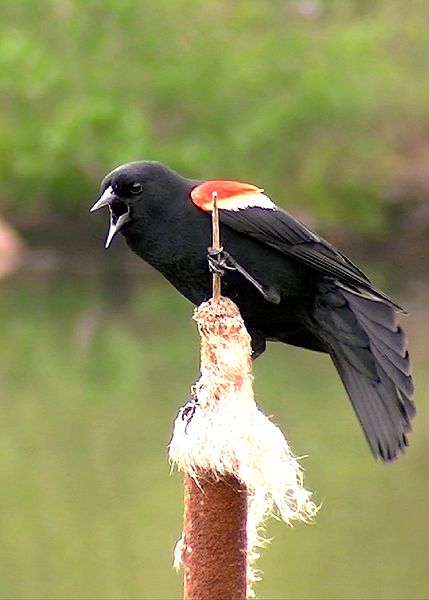Sound guide to the birds of campus
The purpose of this guide is to promote interest in bird-watching and identifying through the use of bird song. It was created in hopes that faculty and students of the University of Connecticut will become more familiar with the birds and other wildlife of UConn. Patience and quiet observation are the keys to a successful viewing of the animals around us!
How to Use this Guide:
The guide is designed so that beginner birders can have a leg-up to bird identification; as vocalizations are one of the most common methods of communication throughout the bird-world, it helps beginners to become familiar with their songs and calls. Start by identifying the habitat you are in, then listen for a few minutes to determine the type of sound you are hearing. Don’t become discouraged and keep a positive outlook!
Contents
- 1 Yellow Warbler
- 2 Common Yellowthroat
- 3 Warbling Vireo
- 4 Baltimore Oriole
- 5 Red-Winged Blackbird
- 6 Eastern Phoebe
- 7 Mourning Dove
- 8 Chipping Sparrow
- 9 Black-capped Chickadee
- 10 Red-eyed Vireo
- 11 Chimney Swift
- 12 American Robin
- 13 Blue Jay
- 14 Bobolink
- 15 Gray Catbird
- 16 Ovenbird
- 17 Tufted Titmouse
- 18 Wood Thrush
- 19 Veery
Yellow Warbler
A high pitched phrase all the same pitch – “Sweet, sweet, sweet, sweeter than sweet!”
Common Yellowthroat
A distinctive: “Witchity witchity witchity witch!” with a drop in pitch on each syllable of the word.
Warbling Vireo
Long and complex song, sounds almost like its asking a long question with the lifted-pitch end note.
Baltimore Oriole
Sweet whistling call that is highly variant; these birds can easily be spotted on tops of thickly growing shrubs.
Red-Winged Blackbird
Harsh and dramatic “Conk-a-reeee!” – this bird’s call is unmistakable once learned.
Eastern Phoebe
Sounds like a raspy voice calling “Fe-beee! Fi breee?”
Mourning Dove
Very sad hoo-ing call; often mistaken for an owl.
Chipping Sparrow
Like a jack-hammer, all notes of the same pitch.
Black-capped Chickadee
Song is a sweetly singing “Fee-beeee, Fee-beee!” with a distinct drop in pitch for second note; call is a quickly rapping “Chicka-dee-dee-dee!”
Red-eyed Vireo
Song is similar to a robin but much higher pitched; phrases come in triplets “Here I am! Where are you?”
Chimney Swift
Call sounds like a bird chittering on fast-forward; often heard from larger groups of swifts flying overhead.
http://www.xeno-canto.org/explore?query=Chaetura+pelagica click here for call]
American Robin
Phrases come in triplets, wavering between two notes “cheer-i-lee, cheer-up!”
Blue Jay
Call is a one noted “Cree!”; high-pitched but rasping
Bobolink
Complex, raspy trill of notes; many birders say this bird always sounds like it is trying to sing too many notes at once.
Gray Catbird
Species call is a raspy “mew” similar to a cat; also a mimid – quickly runs through phrases of other bird species or sounds once, one after the other.
Ovenbird
Song increases in volume as it progresses; a distinct drop in pitch on the second note, this bird seems to cry “Tea-cher, tea-cher, tea-cher!”
Tufted Titmouse
Similar to the ovenbird, but this bird’s call is slightly slower and almost echoes itself “Pe-ter, Pe-ter, Pe-ter!”; there is no change in volume.
Wood Thrush
Clear, sweet and flute-like; this bird has a low and odd-pitched song that can be best described as “Eee-oh-lay-oh!” ending with a high-pitched, twittering rasp.
Veery
Similar to the wood thrush, this bird has a cascading “Veer, veer, veer!” that sounds like multiple notes are being sung at once.
